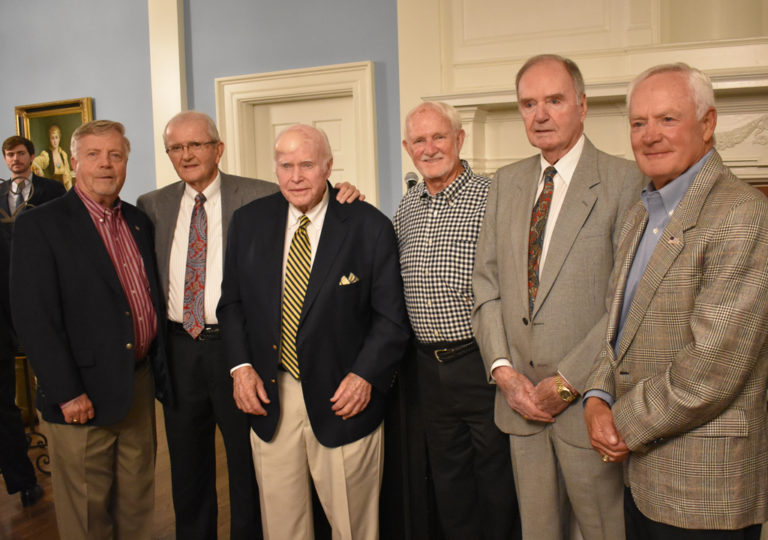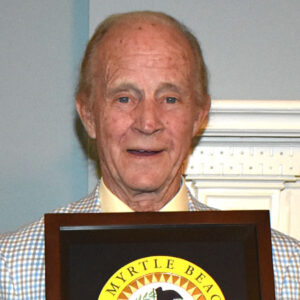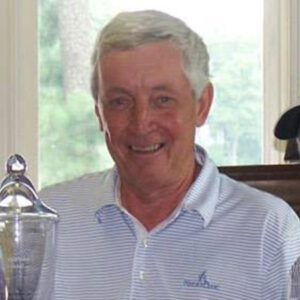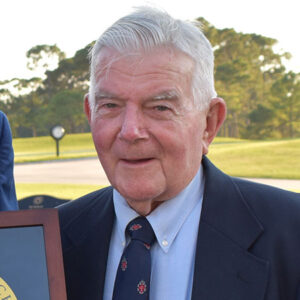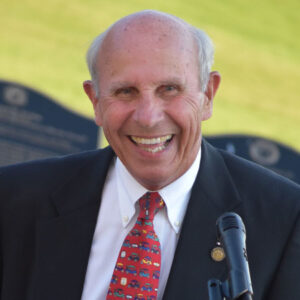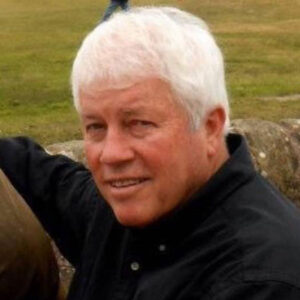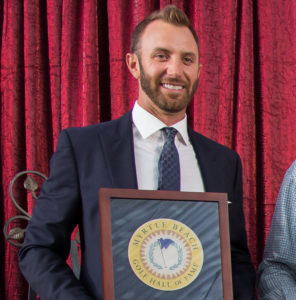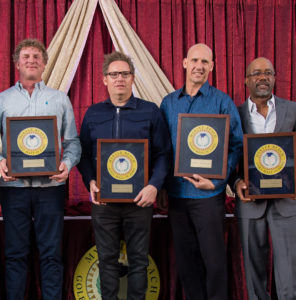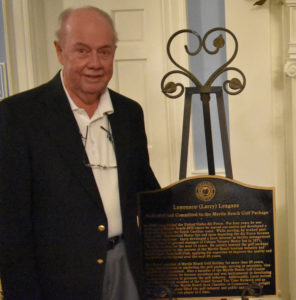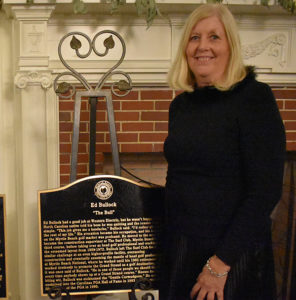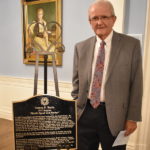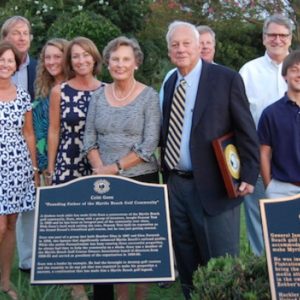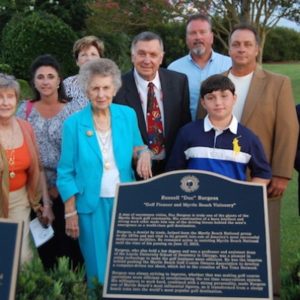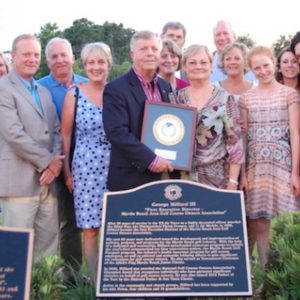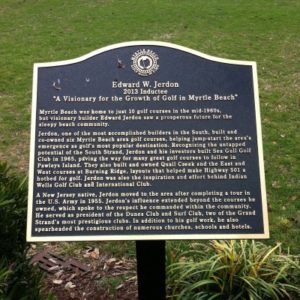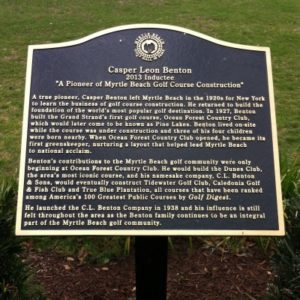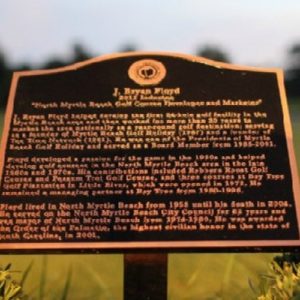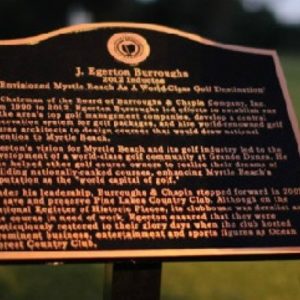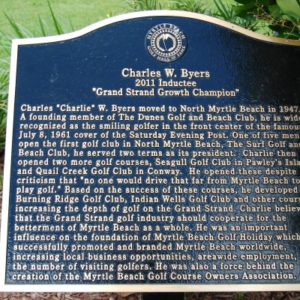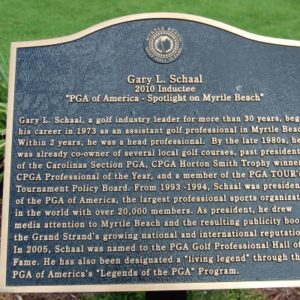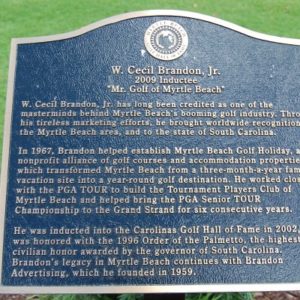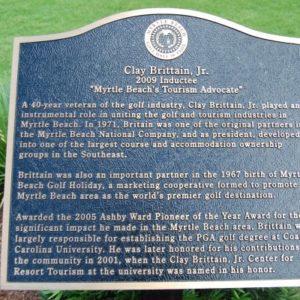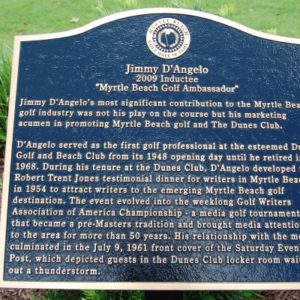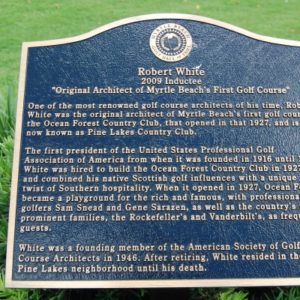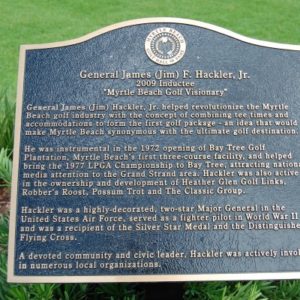
Inductees

Pine Lakes
Country Club
The First Myrtle Beach Golf Course

Myrtle Beach Golf
Hall of Fame
Established 2008
2024 Inductees

Phillip Graham
Phillip began his career in the golf car industry in 1968 when there were only five Myrtle Beach area golf courses. He worked in the golf car industry for more than 50 years until he passed away in 2019 from lung cancer. Over the course of his long career, Phillip’s hard work and dedication were a leading force as the golf industry changed. He provided a strong support system for the golf course owners, as Myrtle Beach and the surrounding area transformed from a small beach community to The Golf Capital of the World.
He worked directly for E-Z-GO as the Branch Manager for more than 30 years before he purchased the business and became the regional distributor for E-Z-GO in 2003. As regional distributor, he was able to offer a more direct level of local service to all customers. Under his leadership, Graham E-Z-GO was able to gain market share and develop strong relationships with customers. Because of his character, he often did business with a handshake and a promise. Thanks to his hard work and dedication throughout his career, Graham E-Z-GO received numerous awards including Branch of the Year, Distributor of Year and became the largest US Distributor for E-Z-GO.
Phillip was a member of Pine Grove Baptist Church in Conway, SC. He served as a deacon for most of his church life and remained a committed member until his death. He was dedicated to helping those less fortunate and growing the church family. He was never one to talk about the many contributions he made to various charities or causes, but he always tried to make the world a better place or a little easier for those who needed help.
Colonel Charles M. Thrash, USAF (Retired)
Charles “Charlie” Thrash entered the Myrtle Beach Golfing Community in 1996 as the General Manager of Bay Tree Golf Plantation. During the next two decades his foresight and initiatives had a lasting impact on Grand Strand golf. Under his leadership Bay Tree became recognized as “Tournament Central” – developing and hosting professional, collegiate, high school, and international junior events. These tournaments exposed thousands of young golfers to the wonders of the golfing opportunities in the Myrtle Beach Area. Bay Tree’s exceptional history, and its efforts in bringing new golfers to the Grand Strand, resulted in Bay Tree Golf Plantation being selected as the first recipient of the Myrtle Beach Area Golf Course Owner’s Association Golf Course of the Year.
Charlie’s second decade in Myrtle Beach golf was spent as the Director of Coastal Carolina University’s PGA Golf Management Program. Under his guidance, the program excelled; becoming the largest such program in the nation. He also played a major role in CCU acquiring their own golf course. The General James Hackler Golf Course became instrumental in supporting both the PGA Golf Management Program and CCU’s athletic and student recreational activities. In 2013 Charlie was recognized for his support of young golfers by being selected as the Father of the Year by the National Father & Son Team Classic.
Colonel Thrash served in the United States Air Force for 26 years. He is a decorated combat pilot whose awards include the Distinguished Flying Cross and the Legion of Merit.
2023 Inductees

Jim Woodring - Internet Marketing Pioneer and Architect of The Modern Golf Package
James (Jim) Chauncey Woodring is highly regarded as the man who revolutionized the electronic golf package business and led Myrtle Beach into the digital age of marketing.
Upon graduating from Kent State University, Jim enjoyed a prodigious 20 plus year career in the retail industry. In 1993 he and his wife Kathy moved to the area where he was named
Vice President of Marketing and Golf Operations for The Myrtle Beach National Company, and a shareholder in Grand Strand Golf & Travel, a leading golf package provider in the area. As the Internet gained mass adoption, Jim saw the need for the Myrtle Beach golf industry to leverage the Internet to grow the market. He spearheaded the advancement of the package and booking technology to benefit the entire Myrtle Beach golf industry and was the architect of several highly successful golf vacation planning and booking websites that drove new and repeat golf package visitors to the area.
Highly regarded for his marketing savvy throughout his career, Jim created new innovative golf packages and developed new ways to attract golfers to our area. In 2012, The Myrtle Beach National Company merged with Burroughs & Chapin Golf Management to form National Golf Management, one of the largest golf course management companies in the US to which Jim was named Executive Vice President responsible for strategic planning and all marketing activities. He retired in 2015.
A man’s man, Jim is best described as an accomplished golfer and affable friend, quick with a big smile, firm handshake, and deep conversation. His incredible career has been driven by his love and commitment to the success of the golf industry in Myrtle Beach.
Matthew Brittain - Innovative Golf Course and Hotel Operations Pioneer
A Myrtle Beach native, James Matthew Brittain is the son of fellow Myrtle Beach Golf Hall of Fame inductee Clay Brittain Jr. Matthew grew up in the hospitality business and as a young man, helped his father run the historic Chesterfield Inn. He received a bachelor’s degree from the University of North Carolina and a master’s degree from the University of South Carolina. After college, he began a highly successful career in hotel management, first in Europe and then later in Washington DC. In 1985 he returned to the Myrtle Beach area with his wife Marie-Claire to become the General Manager of his family’s Sea Island Inn.
A strong advocate for the important role golf has played in the success of the Myrtle Beach area, Matthew worked tirelessly to promote Myrtle Beach as a golf destination and helped drive digital innovation throughout the industry. Highly regarded for his knowledge of technology and operations, Matthew is the driving force behind the growth of Brittain Resorts & Hotels, the Myrtle Beach area’s largest and most successful hotel management company. He also served as the CEO of The Myrtle Beach National Company which eventually became National Golf Management, one of the largest golf course management companies in the U.S.
Always known for giving back to his community, Matthew has served on the Board of Directors for the Grand Strand Tee Time Network, Myrtle Beach Golf Holiday, Myrtle Beach Area Golf Course Owners Association, The Boys & Girls Club, The Long Bay Symphony, and as a Trustee for Brookgreen Gardens.
Jack Himmelsbach’s profound impact on the Myrtle Beach community spans more than four decades. Jack has been a leader in the area golf industry since 1978 as Managing Partner in both The Glens Golf Group, where he was a vital part of designing and building Heather Glen, Glen Dornoch and Shaftesbury Glen golf courses; and Himmelsbach Communications, publisher of On The Green Magazine. Jack has also been a partner in Wicked Stick and Rivers Edge golf courses. Jack’s wide-ranging community involvement includes roles as President & Treasurer of YMCA of Coastal Carolina for 15 years, President of the Myrtle Beach Area Golf Course Owners Association and Board Member for Myrtle Beach Golf Holiday, with service to the Rotary Club of North Myrtle Beach, St. Andrew Catholic Church, Grand Strand Tee Time Network and for two years the U.S. Army. Of Jack’s many endearing qualities, exemplary character has always been the guiding presence in his personal and professional lives. Respect, professionalism, and heartfelt care for all have been his daily hallmark, and Jack has never turned his back on anyone needing his help. And with the great pride he’s always felt in his leading role in launching three of the Grand Strand’s flagship golf courses, Jack is most proud of his four children and how they have all become upstanding adults.
As a lifetime member of the PGA of America with nearly 50 years as a PGA Professional, Gene Weldon was a longtime mentor to fellow PGA Professionals as well as countless individuals who made golf a primary focus in their lives. Gene’s life was driven by helping kids, and where he proudly made his most profound impact in service to others. Gene helped grow the game by developing junior golf programs throughout the Myrtle Beach area, working hand in hand with fellow Myrtle Beach Golf Hall of Fame Inductee Carolyn Cudone to form a junior golf program in her name. Gene was also instrumental in raising several hundred thousand dollars to help fund the Cinghiale Creek Learning Center for The First Tee of Coastal Carolinas, whose programs and Nine Core Values use golf as a tool for teaching life learning skills to area children. Myrtle Beach Golf Hall of Fame Inductee Kelly Tilghman was one of many lifelong beneficiaries of Gene’s mentorship and friendship, and upon Gene’s passing in 2017 she joined the Weldon Family in establishing the Gene’s Dream Foundation – to raise critical funds for The First Tee and other junior golf initiatives, and carry forth Gene’s legacy of caring for local children with golf as a focal point in youth development.
Arthur Herbert Lachicotte, Jr. – Known to all as “Doc” – is recognized as the modern architect of today’s Pawleys Island and The Waccamaw Neck.
After serving in WWII and receiving a Horticulture degree from Clemson University, Doc came back to Pawleys Island to open a nursery and run his family’s business, The Hammock Shops, which he grew into an internationally recognized brand. He later founded The Lachicotte Company in 1991 and pioneered the development of Wachesaw Plantation in Murrells Inlet.
As a partner in Ponderosa Inc., Doc and his friends purchased Caledonia Plantation along the Waccamaw River in 1971 and used it as a place to hunt and fish and get together. In 1992 the group decided to build their first golf course, Caledonia Golf & Fish Club. Known for his attention to details and his love of natural beauty, Doc’s handprints can be found throughout Caledonia, from the preservation of it’s centuries old live oaks and its incredible landscaping to the old english brick and mortar joints used throughout its clubhouse and retaining walls. The visually stunning nature of Caledonia would catapult it to become the most awarded course in the Grand Strand area. Following the success of Caledonia, the group built a second course, True Blue, where again Doc took the lead in working with the architects and contractors to construct a one-of-a-kind golf experience.
Words often used to describe Doc include kind, friendly, giving, gracious, modest, grateful and most of all caring. Always involved in his community, he served on many boards. He is a trustee emeritus of Brookgreen Gardens and a former member of the Clemson University Board of Visitors.
After a decorated 27 year U. S. Navy career followed by employment with the DuPont Company as its’ Tournament Director of the McDonald’s LPGA Championship, McCamish was recruited by Myrtle Beach Golf Holiday as its’ Tournament Director of the Senior PGA TOUR Championship.
After visiting and corresponding with several companies, Eveready Battery Company with its’ Energizer brand was signed as the title sponsor and the Senior PGA TOUR Championship became the Energizer Senior PGA TOUR Championship.
McCamish then became Executive Director of Myrtle Beach Golf Holiday and promptly established an aggressive community effort to bring direct air service to Myrtle Beach, which was needed to help fill 120 golf courses. Additionally, during his tenure, member dues were restructured based on rounds of golf played.
More than words may express, McCamish’s contributions to the Myrtle Beach golf community was only possible as result of support from his wife Carol, daughter Shannon and son Chad.
Larry Young and his family came to Myrtle Beach in 1975 to begin an illustrious career that would lead to the building, ownership and development of 13 area golf courses over four decades. Larry’s portfolio included Marsh Harbour, Oyster Bay, The Heritage Club, Heather Glen and his crown jewel: Legends Golf Resort, featuring its renowned Heathland, Moorland and Parkland courses. Larry’s designs quickly emerged as centerpieces of the Myrtle Beach golf landscape that were instrumental in elevating the market to the “Golf Capital of the World” status it enjoys today. Over the years he also developed a golf package company and owned several area hotels.
Larry’s development impact was also felt beyond the Grand Strand, as he partnered with renowned golf course architect Mike Strantz to build the Stonehouse and Royal New Kent courses in the Williamsburg, Virginia area.
Larry challenged everyone from family to business associates to think more and produce great results. Those who worked closely with Larry loved and respected him as a quiet but kind soul who fulfilled daily duties with his entire family’s interest at heart. He proudly worked side by side with his wife of 59 years, Judy, and his two sons, Kyle and Danny.
Johnson has taken the time to establish a foundation to help youth from Myrtle Beach and beyond learn and play the game. He’s donated more than $500,000 to that cause, much of which goes to scholarships. In 2016 he launched the World Junior Golf Championship, an invitational event that’s already regarded as one of the best anywhere at that level and which he will once again host this weekend. And Thursday is the official opening of his brand-new facility at the Dustin Johnson Golf School at TPC Myrtle Beach, which promises to be nothing but first-class. He wouldn’t do it any other way.
“It’s just about having such a passion for junior golf, and wanting to create opportunities for the players who are coming along behind me,” Johnson said. “That’s important.”
“Something like this makes you feel so humbled and proud. Myrtle Beach became such a big part of my career. So you want to do as much as you can to help those who might need it, maybe get them started on their own career.”
Dustin Hunter Johnson (born June 22, 1984) is an American professional golfer who plays on the PGA Tour. He first became the world number 1-ranked golfer in February 2017 and remained there for 64 consecutive weeks, the 5th longest run as number 1.
Johnson won the 2016 U.S. Open at Oakmont Country Club with a 4-under-par score of 276 for his first major championship. He had previously finished in a tie for second at both the 2011 Open Championship and the 2015 U.S. Open. He also has six World Golf Championships victories, with only Tiger Woods having won more, and he is the first player to win each of the four World Golf Championship events. He is one of the longest drivers on the PGA Tour, having been ranked in the top five annually from 2008 and leading in 2015. By virtue of his 2019 WGC-Mexico Championship win, Johnson became only the third player in Tour history to win a Tour title in each of his first 12 seasons, joining Jack Nicklaus (17) and Tiger Woods (14).
So far Hootie & The Blowfish have raised over $7 million, which has significantly supported the South Carolina Junior Golf Association.
“We had no idea it would turn into what it is today,” said Bryan. “And it’s still rising. We want to take it to new places. It takes 1,000 volunteers every year to pull it off. There’s no way we can thank them enough. It matters. We’re here to help more and more kids.”
To that end, while on stage at the ceremony, they pledged $10,000 to Dustin Johnson’s foundation. We should have expected nothing less. Well done, and surely well-deserved.
Hootie & the Blowfish is an American rock band that was formed in Columbia, South Carolina in 1986. The band’s lineup for most of its existence has been the quartet of Darius Rucker, Mark Bryan, Dean Felber and Jim Sonefeld. The band has been on a break since around 2008 but announced plans for a full reunion tour in 2019.
As of July 2010, the band had charted sixteen singles on various Billboard singles charts and recorded five studio albums. Their debut album, Cracked Rear View (1994), is the 19th-best-selling album of all time in the United States, and was certified platinum 21 times. They have sold over 21 million copies of their albums in the United States. The group was also popular in Canada, having three number-one singles in the country.
In 1964 Larry joined the United States Air Force. For four years he was stationed at Myrtle Beach AFB where he served our nation and developed a deep affection for the South Carolina coast. While serving, he worked part-time at the Thunderbird Motor Inn and upon departing the Air Force became a full-time employee. Larry developed a keen interest in facility management and hired as General Manager of Cabana Terrace Motor Inn in 1971 where he worked for the next 14 years. He quickly learned the golf package was instrumental to the success of the Myrtle Beach tourism industry and leased Eagle Nest Golf Club applying his expertise to improve the quality and reputation of the layout over the next 20 years.
As a board member of Myrtle Beach Golf Holiday for more than 20 years, Larry was dedicated to marketing the golf package, serving as secretary, vice president, and president. Also, a member of the Myrtle Beach Golf Course Owners Association, he became president and was instrumental in the development of numerous initiatives to promote the golf industry. Additionally, Larry served as a charter member of the Grand Strand Tee Time Network and as Vice President of the MB Area Chamber of Commerce. His delight in promoting the game lifted the golf industry and public appreciation of Myrtle Beach golf, one player at a time.
Ed Bullock had a good job at Western Electric, but he wasn’t happy. The North Carolina native told his boss he was quitting and the reason was simple: “This job gives me a headache – I’d rather play golf the rest of my life,” Bullock said. His avocation became his occupation and his impact on the Myrtle Beach golf market was profound.
He moved to the area to become the construction supervisor at The Surf Club, Myrtle Beach’s third course, before taking over as head pro, working at the esteemed layout from 1959-1972.
Bullock left The Surf Club for a similar challenge at an even higher profile facility, overseeing construction and eventually assuming the mantle of head pro at Myrtle Beach National, where he worked until 1985 retirement. He worked tirelessly to promote the Grand Strand as a golf destination and it was once said of Bullock, “He is one of those people we should thank every time anybody shows up at a Grand Strand course.” Known for his biting wit, Bullock was nicknamed the “Gentle Curmudgeon.” He was enshrined into the Carolinas PGA Hall of Fame in 1993 and name a life member of the PGA in 1990.
Robert J. LeComte was born in Brooklyn, NY, moved to Wilmington, DE in 1955, and enjoyed a productive 37-year career in marketing at E. I. du Pont de Nemours and Company. Upon retiring from DuPont, LeComte brought his expertise and business acumen to Myrtle Beach, where he joined Myrtle Beach Golf Holiday.
Over the course of his career, LeComte created the two most significant title sponsorships in the destination’s history. He brought in DuPont as a sponsor to the World Amateur Handicap Championship, leading to one of the longest title-sponsor relationships in all of sports.
With LeComte as the driving force, the World Amateur became an iconic event in the world of golf, attracting players from around the globe. In addition to leading the World Am, he also assumed additional responsibilities in promoting his favorite golf destination.
LeComte’s tenacity led to securing Energizer as a title sponsor for the Senior Tour Championship, bringing a high-profile, professional golf event to Myrtle Beach. The Senior Tour Championship provided international exposure as well as a national live television audience, showcasing the Golf Capital of the World.
LeComte’s dedication and professionalism will forever have an impact on the community he cherished and the game he loved.
In 1965, Vernon Brake entered the hotel business on the Grand Strand. He quickly realized that to be successful as a hotel owner, he also needed to be involved in the golf packaging business. In 1970, he and several friends purchased The Breakers Hotel and, as managing partner for 34 years, Brake saw the property grow from its original 71 units to 667 units. Golf was a large contributor to this growth. As a result, The Breakers joined with other partners to form Myrtle Beach National Golf Club (MBN), which built three golf courses designed by the Arnold Palmer Group. MBN ultimately developed 10 courses and became one of the driving forces behind the area’s growth.
As golf on the Grand Strand exploded, Brake became an integral part of the Myrtle Beach Golf Holiday Board of Directors and, for 28 years, served in all capacities.
As the need for computerized golf reservations grew, Brake became a charter Board member of the Grand Strand Tee Time Network. He served as a charter Board member of the Hotel/Motel Association and as a Board member of the Chamber of Commerce, as well as the Dunes Golf and Beach Club. He was also instrumental in the development of Arrowhead Country Club.
Retiring at age 74, Brake is a brilliant example of finding what you love to do and making it your life’s work.
Edward Burroughs hails from one of the most significant families in Myrtle Beach’s history, and his unerring vision and leadership were instrumental to the area’s growth throughout the 20th century. Burroughs was the guiding force behind decisions that led to the donation of land that is now Myrtle Beach State Park, helped found Coastal Carolina University, and was vital to the development of Highway 17 Bypass.
This Grand Strand giant was also essential to Myrtle Beach’s emergence as an international golf destination. He sold land to the Dunes Club, allowing for the construction of most iconic layout among Myrtle Beach golf courses, but he is most renowned for his development of Myrtlewood Golf Club.
The area’s first 36-hole golf course, Myrtlewood was located in the middle of town and helped jump start Myrtle Beach’s transformation from sleepy beach community to acclaimed golf destination.
One of the most decorated junior golfers in Grand Strand history, the game has been a vital part of Kelly Tilghman’s life. She lived on the third hole at the Surf Club, one of Myrtle Beach golf’s most venerable layouts, and her family owned Gator Hole Golf Club, where Tilghman worked every job imaginable and honed a game that earned her a scholarship to Duke University.
Upon graduation from Duke, she played professionally across the globe for four years before retiring to take a position with the then upstart Golf Channel. Tilghman’s stature grew along with the network’s, and she went on to become the first full-time female play-by-play broadcaster in American sports history when she led PGA Tour coverage on Golf Channel.
Her play-by-play work eventually extended to NBC’s coverage of the 2012 London Olympics, but Tilghman has carved out a hall of fame career – in Myrtle Beach and beyond – as a result of her work in golf.
While her star rose nationally, Tilghman continued to maintain ties to the Grand Strand. Over the years, she has returned to the area on numerous occasions, along with Golf Channel’s cameras, to highlight the work of the Myrtle Beach Chapter of the First Tee.
Goings started at the club as a dishwasher, but moved outdoors where he became the head looper at Myrtle Beach’s most famed course. A razor sharp memory made Goings an outstanding caddy master, despite only playing the game once in his life. His personality endeared him to Dunes Club members and guests alike. Fellow Myrtle Beach Golf Hall of Famer Jimmy D’Angelo once said of Goings, “He treats everybody like they are the President of the United States … He’s the world’s best.” Goings worked at the Dunes Club for 53 years, setting a standard for work ethic and service that served the entire Myrtle Beach golf community well.
He married Maxine Hughes Goings on March 26, 1964. The couple had two daughters, Leta and Philecia, who graduated from Coastal Carolina University. Goings lived his entire life in Georgetown and Horry counties, and when he wasn’t with his family or working, he was likely at Mt. Olive AME where he served as an usher and trustee.
Miles immediately established a goal to improve the profile of Pine Lakes and was wildly successful. He coined the venerable Robert White design as the “Granddaddy,” ensuring everyone knew that Pine Lakes was the birthplace of Myrtle Beach golf. Under his direction the once languishing course developed a thriving membership and rivaled the Dunes Club as the area’s premier social hotspot. It was Miles’ idea to serve clam chowder at the turn and he also brought Rolls Royce golf carts to the course, marketing plays that attracted national attention to Pine Lakes and the area. While Miles was most known for his success at the Granddaddy, he worked with fellow Myrtle Beach Golf Hall of Fame member Cecil Brandon to help launch Myrtle Beach Golf Holiday. When the golf package was born in Myrtle Beach, Miles sent a limo to ferry the first package customers to the course. His willingness and ability to think outside the box helped Myrtle Beach become the destination it is today.
Miles married Beula Gatewood on December 31, 1959. They have two children, Scott and Melissa.
A tireless work ethic has made Critt Gore a cornerstone of the Myrtle Beach golf community. Gore, along with a group of investors, bought Possum Trot in 1980 and he has been an integral part of the community ever since. With Gore’s hard work setting the tone, Possum Trot built its reputation as the Grand Strand’s friendliest golf course, but he was just getting started.
Gore was part of a group that built Heather Glen in 1987 and Glen Dornoch in 1996, two layouts that significantly enhanced Myrtle Beach’s national profile. While the native Pennsylvanian was busy running three successful properties, he always had time to help the community as a whole. Gore was a member of the Myrtle Beach Golf Course Owners Association board of directors from 1986-89 and served as president of the organization in 1988-89.
Gore was a leader by example. He had the foresight to develop golf courses and the tenacity to do any job that was required to make his properties a success, a combination that has made him a Myrtle Beach golf legend.
A man of uncommon vision, Doc Burgess is truly one of the giants of the Myrtle Beach golf community. His combination of a keen intellect and strong work ethic made him one of the driving forces behind the area’s emergence as a world-class golf destination.
Burgess, a dentist by trade, helped form the Myrtle Beach National group in the 1970s and was vital to its growth into one of America’s most successful multi-course facilities. He remained active in assisting Myrtle Beach National until the time of his passing on June 17, 2013.
Burgess, who also held a law degree and was a professor and assistant dean of the Loyola University School of Dentistry in Chicago, was a pioneer in using technology to make the golf business more efficient. He was the impetus behind pushing the Myrtle Beach Golf Course Owners Association to develop a computer-driven tee sheet, which led to the creation of Tee Time Network.
Burgess was always striving to improve, whether that was making golf course operations more efficient or revolutionizing the tee time reservations system. His willingness to work hard, combined with a strong personality, made Burgess one of Myrtle Beach’s most influential figures, as it was transformed from a sleepy beach town into the world’s most popular golf destination.
After 26 years of service in the U.S. Air Force as a highly decorated officer awarded the Silver Star, two Distinguished Flying Crosses, and 11 Air Medals, in 1988, Hilliard became the first Executive Director of the Myrtle Beach Area Golf Course Owners Association.
His next 26 years were dedicated toward the development and implementation of policies, projects, and programs for the Myrtle Beach golf industry. With the help of a dedicated golf community, Hilliard spearheaded numerous programs to include the area’s first computerized tee time reservation system, the Myrtle Beach Golf Passport program, the industry’s health insurance program for golf course employees, as well as national and statewide lobbying efforts to gain significant tax reductions for golf course owners. He also served as Tournament Chairman of the AJGA’s Ping Myrtle Beach Junior Classic.
In 2005, Hilliard was awarded the National Golf Course Owners Association’s Champion Award that recognizes individuals who have garnered significant victories on behalf of golf course owners. He was also named 2012 Father of the Year by the National Father & Son Team Classic.
Active in the community and church groups, Hilliard has been supported by his wife Helen, four children and 14 grandchildren.
Myrtle Beach was home to just 10 golf courses in the mid-1960s, but visionary builder Edward Jerdon saw a prosperous future for the sleepy beach community.
Jerdon, one of the most accomplished builders in the South, built and co-owned six Myrtle Beach area golf courses, helping jump-start the area’s emergence as golf’s most popular destination. Recognizing the untapped potential of the South Strand, Jerdon and his investors built Sea Gull Golf Club in 1965, paving the way for many great golf courses to follow in Pawleys Island. They also built and owned Quail Creek and the East and West courses at Burning Ridge, layouts that helped make Highway 501 a hotbed for golf. Jerdon was also the inspiration and effort behind Indian Wells Golf Club and International Club.
A New Jersey native, Jerdon moved to the area after completing a tour in the U.S. Army in 1955. Jerdon’s influence extended beyond the courses he owned, which spoke to the respect he commanded within the community. He served as president of the Dunes Club and Surf Club, two of the Grand Strand’s most prestigious clubs. In addition to his golf work, he also spearheaded the construction of numerous churches, schools and hotels.
A true pioneer, Casper Benton left Myrtle Beach in the 1920s for New York to learn the business of golf course instruction. He returned to build the foundation of the world’s most popular golf destination. In 1927, Benton built the Grand Strand’s first golf course, Ocean Forest Country Club, which would later come to be known as Pine Lakes. Benton lived on-site while the courses were under construction and three of his four children were born nearby. When Ocean Forest Country Club opened, he became its first greenskeeper, nurturing a layout that helped lead Myrtle Beach to national acclaim.
Benton’s contributions to the Myrtle Beach golf community were only beginnning at Ocean Forest Country Club. He would build the Dunes Club, the area’s most iconic course, and his namesake company, C.L. Benton & Sons, would eventually construct Tidewater Golf Club, Caledonia Golf & Fish Club and True Blue Plantation, all courses that have been ranked among America’s 100 Greatest Public Courses by Golf Digest.
He launched the C.L. Benton Company in 1938 and his influence is still felt throughout the area as the Benton family continues to be an integral part of the Myrtle Beach golf community.
J. Bryan Floyd helped develop the first 54-hole golf facility in the Myrtle Beach area and then worked for more than 30 years to market the area nationally as a year-round golf destination serving as a founder of Myrtle Beach Golf Holiday (1967) and a founder of Tee Time Network. He was one of the Presidents of Myrtle Beach Golf Holiday and served as a Board Member from 1986-2001.
Floyd developed a passion for the game in the 1950s and helped develop golf courses in the North Myrtle Beach area in the late 1960s and 1970s. His contributions included Robbers Roost Golf Course and Possum Trot Golf Course, and three courses at Bay Tree Golf Plantation in Little River, which were opened in 1972. He remained a managing partner at Bay Tree from 1980-1996.
Floyd lived in North Myrtle Beach from 1958 until his death in 2004. He served on the North Myrtle Beach City Council for 22 years and was mayor of North Myrtle Beach from 1974-1980. He was awarded the Order of the Palmetto, the highest civilian honor in the state of South Carolina, in 2001.
As Chairman of the Board for Burroughs & Chapin, Inc. from 1990-2012, Egerton Burroughs led efforts to establish one of the area’s top golf management companies, develop a central reservation option for golf packages, and hire world-renowned golf course architects to design courses that would draw national attention to Myrtle Beach.
Egerton’s vision for Myrtle Beach and its golf industry led to development of a world-class community at Grande Dunes. He also helped other golf course owners to realize their dreams of building nationally-ranked courses, enhancing Myrtle Beach’s reputation as the “world capital of golf.”
Under his leadership, Burroughs & Chapin stepped forward in 2001 to save and preserve Pine Lakes Country Club. Although on the National Register of Historic Places, its clubhouse was derelict and the course in need of work. Egerton assured that they were meticulously restored to their glory days when the club hosted prominent business, entertainment, and sports figures as Ocean Forest Country Club.
Charles “Charlie” W. Byers moved to North Myrtle Beach in 1947. A founding member of the Dunes Golf and Beach Club, he is widely recognized as the smiling golfer in the front center of the famous July 8, 1961 cover of the Saturday Evening Post. One of five men to open the first golf club in North Myrtle Beach, The Surf Golf and Beach Club, he served two terms as its first president. Charlie then opened two more golf courses, Seagull Golf Club in Pawleys Island and Quail Creek Golf Club in Conway. He opened these despite criticism that “no one would drive that far from Myrtle Beach to play golf.” Based on the success of these courses, he developed Burning Ridge Golf Club, Indian Wells Golf Club and Crown Park, increasing the depth of golf on the Grand Strand. Charlie believed that the Grand Strand golf industry should cooperate for the betterment of Myrtle Beach as a whole. He was an important influence on the foundation of Myrtle Beach Golf Holiday which has successfully promoted and branded Myrtle Beach worldwide, increasing local business opportunities, area-wide employment, and the number of visiting golfers. He was also a force behind the creation of the Golf Course Owners Association.
Paul Himmelsbach moved from New York in 1977 to join the Grand Strand golf industry. He leveraged his relationships with national media to position Myrtle Beach among the world’s premier golf vacation destinations. A founder of On The Green magazine and its sister publication, On The Beach, his publishing ventures have informed millions of visitors about Myrtle Beach and its world-class golf courses. As a partner in two advertising agencies providing golf marketing services, he spearheaded the creation of a marketing cooperative between On The Green and the number one golf magazine in America, Golf Digest, that showcased the quality and quantity of golf courses in Myrtle Beach and enhanced the area’s brand. In 1984, he co-created the World Amateur Handicap. Competitors and golf vendors come to Myrtle Beach annually from every state and many foreign countries for a week of golf, generating millions of dollars for the economy and worldwide publicity for Myrtle Beach golf. A golf course developer, Paul partnered with others to create The Glens Golf Group, known for award-winning golf courses, including Heather Glen, Glen Dornoch and Shaftesbury Glen, that are are ranked among the Grand Strand’s best.
Gary L. Schaal, a golf industry leader for more than 30 years, began his career in 1973 as an assistant golf professional in Myrtle Beach. Within 2 years, he was a head professional. By the late 1980s, he was already co-owner of several local golf courses, past president of the Carolinas Section PGA, CPGA Horton Smith Trophy winner, CPGA Professional of the Year, and a member of the PGA TOUR’s Tournament Policy Board. From 1993 to 1994, Schaal was president of the PGA of America, the largest professional sports organization in the world with over 20,000 members. As president, he drew media attention to Myrtle Beach and the resulting publicity boosted the Grand Strand’s growing national and international reputation. In 2005, Schaal was named to the PGA Golf Professional Hall of Fame. He has also been designated a “living Legend” through the PGA of America’s “Legends of the PGA” Program.
George W. “Buster” Bryan was one of the founding fathers of the golf package business. His leadership transformed Myrtle Beach from a sleepy beach town with a 3-month season into a year-round golf vacation destination. Bryan built the Caravelle Hotel in 1959 and soon realized that Myrtle Beach could expand its tourist season beyond summer by offering golf vacation packages. In the 1950s, he created Myrtle Beach’s first golf promotion group, “Golf-o-tel”, combining 8 courses and 8 hotels into a marketing cooperative. The group bought advertising that took Myrtle Beach’s package message far beyond the Carolinas. Bryan understood the power of positive publicity. He raised funds to host a gathering of influential golf writers and became a driving force behind the Golf Writers Championship. For 50 years, the gathering ensured that writers stopped in Myrtle Beach on their annual trips to cover The Masters and recommended golf vacations here.
W. Cecil Brandon, Jr. has long been credited as the mastermind behind Myrtle Beach’s booming golf industry. Through his tireless marketing efforts, he brought worldwide recognition to the Myrtle Beach area, and to the state of South Carolina.
In 1967, Brandon helped found Myrtle Beach Golf Holiday, a nonprofit alliance of golf courses and accommodation properties, which transformed Myrtle Beach from a three-month-a-year family vacation site into a year-round golf destination. He worked closely with the PGA TOUR to build the Tournament Players Club of Myrtle Beach and helped bring the PGA Senior TOUR Championship to the Grand Strand for six consecutive years.
He was inducted into the Carolinas Golf Hall of Fame in 2002, and was honored with the 1996 Order of the Palmetto, the highest civilian honor awarded by the governor of South Carolina. Brandon’s legacy in Myrtle Beach continues with Brandon Advertising, which he founded in 1959.
A 40-year veteran of the golf industry, Clay Brittain, Jr. played an instrumental role in uniting the golf and tourism industries in Myrtle Beach. Brittain was also an important partner in the birth of Myrtle Beach Golf Holiday, a marketing cooperative formed with the goal of promoting the Myrtle Beach area as the world’s premier golf destination, in 1967.
In 1971, Britain was one of the original partners in the Myrtle Beach National Company and developed it into one of the largest course and accommodation ownership groups in the Southeast.
Awarded the 2005 Ashby Ward Pioneer of the Year Award for the significant impact he made in the Myrtle Beach area, Brittain was largely responsible for establishing the PGA golf degree at Coastal Carolina University. He was later honored for his contributions to the community in 2001, when the Clay Brittain, Jr. Center for Resort Tourism at the university was named in his honor.
Carolyn Cassidy Cudone will always be remembered as the pioneer of the Myrtle Beach Junior Golf Association. Disenchanted by the lack of collegiate golfers representing the “Golf Capital of the World”, Cudone created the area’s original junior golf program in 1981 and was the driving force behind the program over the next 20 years. Thanks to her insight and hard work, more than 15 of her Grand Strand area junior golfers earned college golf scholarships.
One of the finest women golfers of her generation, Cudone captured 10 U.S. Women’s Senior Amateur Championships, including five consecutive wins from 1968 to 1972, the longest consecutive winning streak in any USGA Championship. In addition to capturing the South Carolina Women’s Amateur title a record seven times, Cudone was a member of two U.S. Curtis Cup Match teams (a team member in 1956 and the team captain in 1970). She was inducted into the South Carolina Golf Hall of Fame in 1979.
Jimmy D’Angelo’s most significant contribution to the Myrtle Beach golf industry was not limited to his play on the course, but also his marketing acumen in promoting Myrtle Beach golf and The Dunes Club.
D’Angelo served as the first golf professional at the esteemed Dunes Golf and Beach Club from its 1948 opening day until he retired in 1968. During his tenure at the Dunes Club, D’Angelo developed the Robert Trent Jones testimonial dinner for writers in Myrtle Beach in 1954 to attract writers to the emerging Myrtle Beach golf destination. The event evolved into the weeklong Golf Writers Association of America Championship – a media golf tournament that became a pre-Masters tradition and brought media attention to the area for more than 50 years. His relationship with the media culminated in the July 9, 1961 front cover of the Saturday Evening Post, which depicted guests in the Dunes Club locker room waiting out a thunderstorm.
One of the most renowned golf course architects of his time, Robert White was the original architect of Myrtle Beach’s first golf course, the Ocean Forest Country Club, that opened in 1927, and is now known as Pine Lakes Country Club.
The first president of the United States Professional Golf Association of America from when it was founded in 1916 until 1920, White was hired to build the Ocean Forest Country Club in 1927 and combined his native Scottish golf influences with a unique twist of Southern hospitality. When it opened in 1927, Ocean Forest became a playground for the rich and famous, with professional golfers Sam Snead and Gene Sarazen, as well as the country’s most prominent families, the Rockefellers and Vanderbilts, as frequent guests.
White was a founding member of the American Society of Golf Course Architects in 1946.
After retiring, White was a Pine Lakes resident until his death.
While on a golf vacation, General James (Jim) Hackler, Jr. revolutionized the Myrtle Beach golf industry with the concept of combining tee times and accommodations to form the first golf package – an idea that would make Myrtle Beach synonymous with the ultimate golf destination.
He was instrumental in the 1972 opening of Bay Tree Golf Plantation, Myrtle Beach’s first three-course facility, and helped bring the 1977 LPGA Championship to Bay Tree, attracting national media attention to the Grand Strand area. Hackler was also active in the ownership and development of Heather Glen Golf Links, Robber’s Roost, Possum Trot and The Classic Group.
Hackler was a highly-decorated, two-star Major General in the United States Air Force, served as a fighter pilot in World War II and was a recipient of the Silver Star Medal and the Distinguished Flying Cross.
A devoted community and civic leader, Hackler was actively involved in numerous local organizations.
